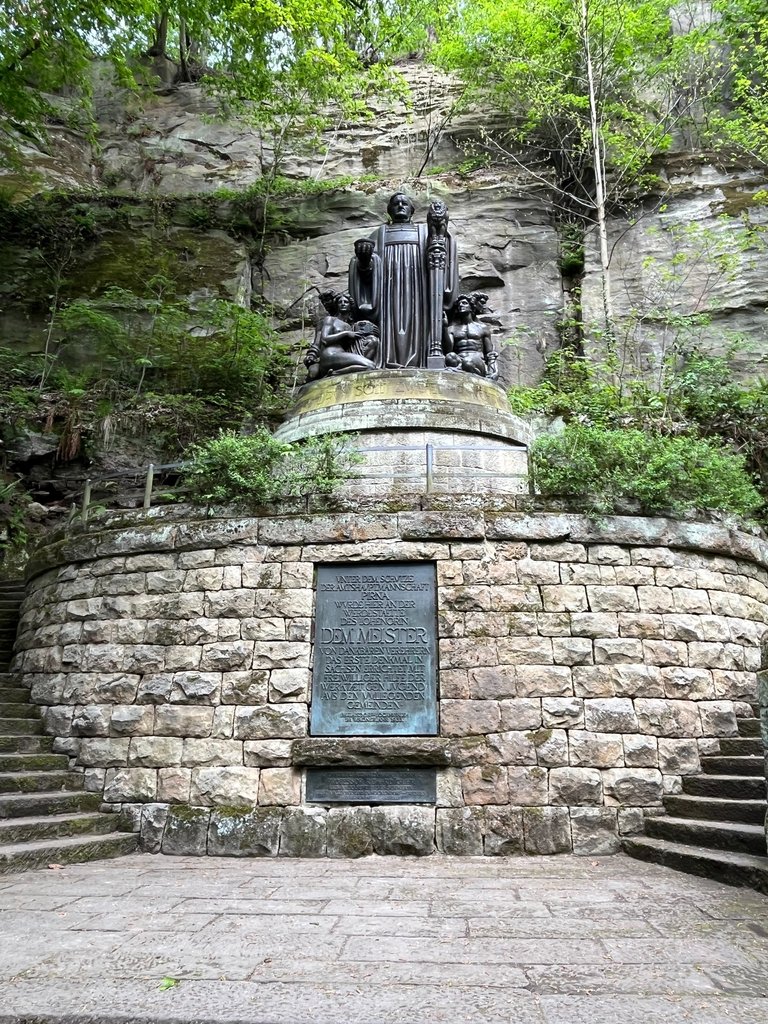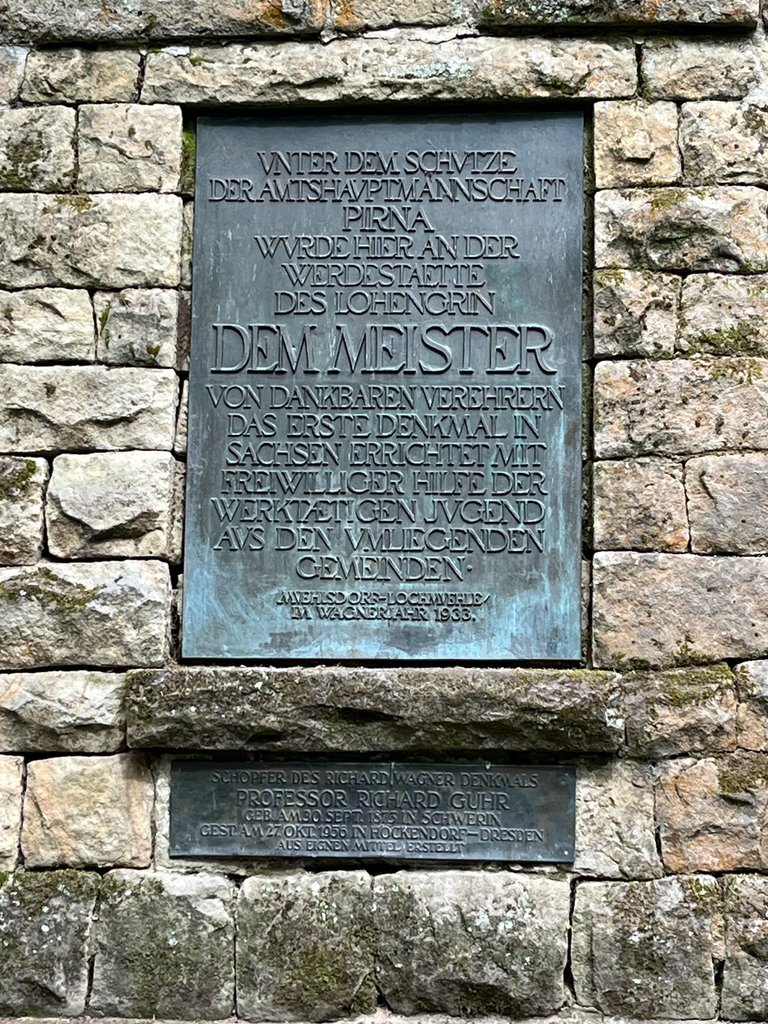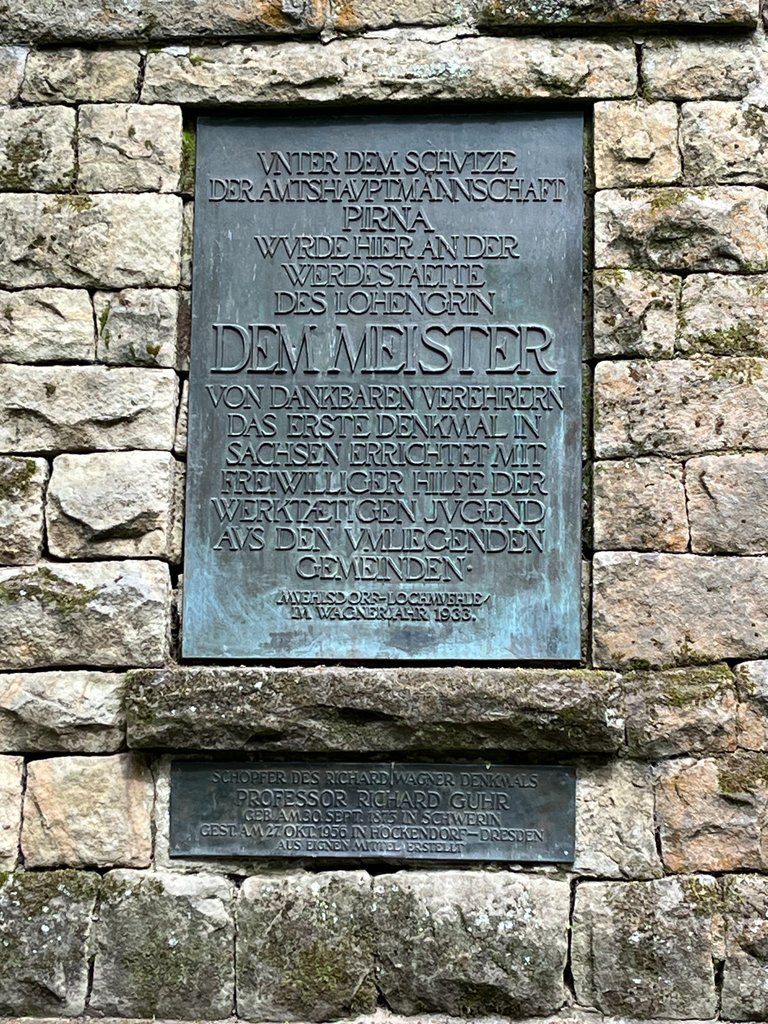Introduction
Saxon Switzerland, known for its impressive sandstone formations and picturesque landscapes, is also home to cultural treasures of great importance. One of these important cultural monuments is the Richard Wagner Monument, which is deeply rooted in history and art. This monument commemorates the famous composer Richard Wagner and his connection to this region.

History of the monument
In 1846, the Dresden court conductor Richard Wagner wandered through the area several times with his dog Peps during his vacation in Graupa. The “roaring weir in the dark rocky ground” inspired him to write the notes for the world-famous opera “Lohengrin”. This deep connection to the landscape led to the creation of the monument. In honor of the 100th anniversary of Richard Wagner's birth in 1913, Professor Richard Guhr wanted to create a white marble monument to him. It was intended for the Great Garden in Dresden, but was not well received by the royal family. As a result, Dresden showed no interest in the sculpture in 1923. The sculpture was finally cast in bronze in 1928. Carl Staude then provided the space for the monument on his property here at Lochmühle, the place where the opera “Lohengrin” was written, and took over the substructure. The site was leased to the municipality of Mühlsdorf for 99 years. A memorial plaque commemorates the 19 helpers of the voluntary labor service from the surrounding communities. On May 21, 1933, the monument was inaugurated on Wagner's 120th birthday to the sound of fanfares played by the Dresden court trumpeters.
Significance of the monument
The Richard Wagner Monument is not only a tribute to the great composer, but also a symbol of the cultural connection between Wagner and Saxon Switzerland. Wagner found inspiration for his works in the nature and landscapes of this region, especially for the opera “Lohengrin”. The monument therefore serves as a reminder of this creative connection and as a place of remembrance for Wagner's followers and music lovers.

Artistic execution
The monument consists of a bronze sculpture that was originally planned as a white marble monument. This sculpture shows Wagner in an impressive pose that reflects his importance and influence on music history. The bronze sculpture was cast in 1928 and is an example of the high level of craftsmanship of the time. A special aspect of the memorial is the sandstone bench, which was symbolically erected as Wagner's “favorite spot”. This bench adds a personal touch to the memorial and links it even more closely to Wagner's stays in Saxon Switzerland.
Conclusion
The Richard Wagner Monument in Saxon Switzerland is an important cultural legacy that honors the deep connection between Richard Wagner and this picturesque region. The history of the monument, its significance and the artistic execution make it an important attraction for culture enthusiasts and Wagner fans. A visit to this monument not only offers an insight into Wagner's life and work, but also into the impressive nature and history of Saxon Switzerland.
Das Richard-Wagner-Denkmal in der Sächsischen Schweiz: Ein kulturelles Erbe
Einleitung
Die Sächsische Schweiz, bekannt für ihre beeindruckenden Sandsteinformationen und malerischen Landschaften, beherbergt auch kulturelle Schätze von großer Bedeutung. Eines dieser bedeutenden Kulturdenkmäler ist das Richard-Wagner-Denkmal, das tief in der Geschichte und Kunst verankert ist. Dieses Denkmal erinnert an den berühmten Komponisten Richard Wagner und seine Verbindung zu dieser Region.

Geschichte des Denkmals
Im Jahr 1846 wanderte der Dresdener Hofkapellmeister Richard Wagner während seines Urlaubs in Graupa mehrfach mit seinem Hund Peps durch die Gegend. Die "brausende Wehr im finsteren Felsengrund" inspirierte ihn zu den Noten der weltbekannten Oper "Lohengrin". Diese tiefe Verbindung zur Landschaft führte zur Entstehung des Denkmals.
Zu Ehren des 100. Geburtstags von Richard Wagner im Jahr 1913 wollte ihm Professor Richard Guhr ein Denkmal aus weißem Marmor schaffen. Es war für den Großen Garten in Dresden bestimmt, fand aber im Königshaus keinen Zuspruch. Daher zeigte Dresden im Jahr 1923 kein Interesse an der Skulptur. Schließlich wurde die Skulptur 1928 in Bronze gegossen. Carl Staude stellte daraufhin hier an der Lochmühle, dem Entstehungsort der Oper "Lohengrin", auf seinem Grundstück den Platz für das Denkmal zur Verfügung und übernahm den Unterbau. Der Platz wurde für 99 Jahre an die Gemeinde Mühlsdorf verpachtet. Eine Gedenktafel erinnert an die 19 Helfer des freiwilligen Arbeitsdienstes der umliegenden Gemeinden. Am 21. Mai 1933 wurde das Denkmal zum 120. Geburtstag Wagners unter Fanfarenklängen der Dresdener Hoftrumpeter eingeweiht.
Bedeutung des Denkmals
Das Richard-Wagner-Denkmal ist nicht nur ein Tribut an den großen Komponisten, sondern auch ein Symbol für die kulturelle Verbindung zwischen Wagner und der Sächsischen Schweiz. Wagner fand in der Natur und den Landschaften dieser Region Inspiration für seine Werke, insbesondere für die Oper "Lohengrin". Das Denkmal dient daher als Erinnerung an diese kreative Verbindung und als Ort des Gedenkens für Wagners Anhänger und Musikliebhaber.

Künstlerische Ausführung
Das Denkmal besteht aus einer Bronzeskulptur, die ursprünglich als weißes Marmordenkmal geplant war. Diese Skulptur zeigt Wagner in einer beeindruckenden Pose, die seine Bedeutung und seinen Einfluss auf die Musikgeschichte widerspiegelt. Die Bronzeskulptur wurde 1928 gegossen und ist ein Beispiel für die hohe Kunstfertigkeit der damaligen Zeit. Ein besonderer Aspekt des Denkmals ist die Sandsteinbank, die als Wagners überliefertes "Lieblingsplätzchen" symbolisch aufgestellt wurde. Diese Bank fügt dem Denkmal eine persönliche Note hinzu und verbindet es noch stärker mit Wagners Aufenthalten in der Sächsischen Schweiz.
Fazit
Das Richard-Wagner-Denkmal in der Sächsischen Schweiz ist ein bedeutendes kulturelles Erbe, das die tiefe Verbindung zwischen Richard Wagner und dieser malerischen Region würdigt. Die Geschichte des Denkmals, seine Bedeutung und die kunstvolle Ausführung machen es zu einem wichtigen Anziehungspunkt für Kulturinteressierte und Wagner-Fans. Ein Besuch dieses Denkmals bietet nicht nur einen Einblick in Wagners Leben und Werk, sondern auch in die beeindruckende Natur und Geschichte der Sächsischen Schweiz.
Congratulations, your post has been added to WorldMapPin! 🎉
Did you know you have your own profile map?
And every post has their own map too!
Want to have your post on the map too?
Congratulations, your post has been added to Pinmapple! 🎉🥳🍍
Did you know you have your own profile map?
And every post has their own map too!
Want to have your post on the map too?
Congratulations @travelflower! You received a sweet smile from TravelFeed. We love your work so keep up the good job. 😊
Thanks for using TravelFeed!
@for91days (TravelFeed team)
PS: Did you know that we launched the truvvl app? With truvvl, you can create travel stories on the go from your phone and swipe through nearby stories from other TravelFeed users. It is available on the Apple App Store and Google Play.
Congratulations @travelflower! You have completed the following achievement on the Hive blockchain And have been rewarded with New badge(s)
Your next target is to reach 12000 upvotes.
You can view your badges on your board and compare yourself to others in the Ranking
If you no longer want to receive notifications, reply to this comment with the word
STOPCheck out our last posts: